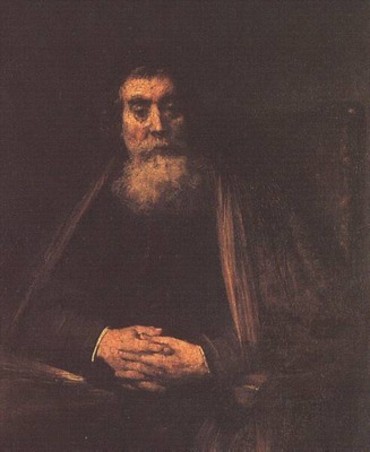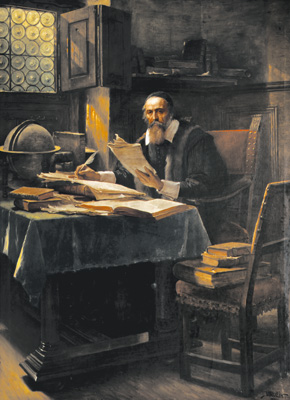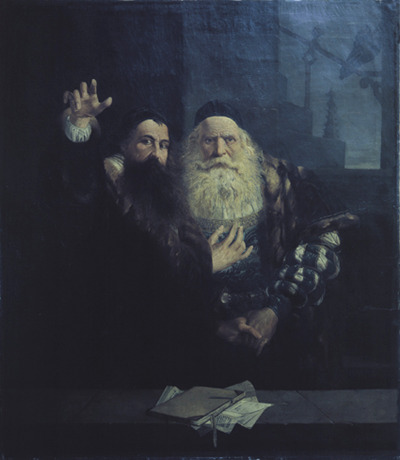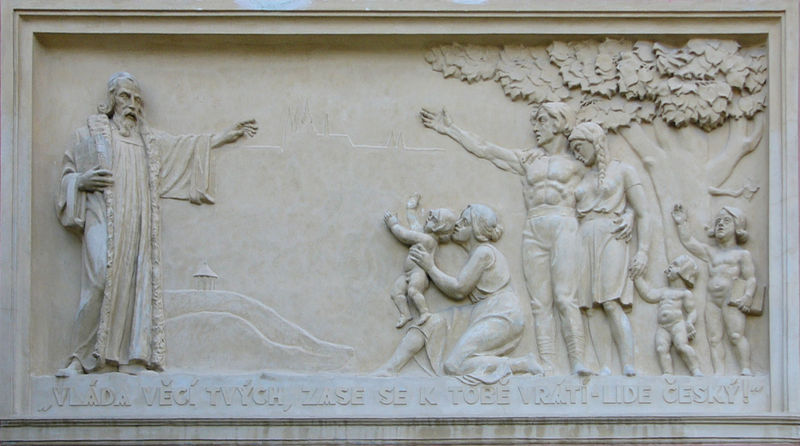<Back to Index>
- Educator John Amos Comenius, 1592
- Writer Arsčne Houssaye (Housset), 1815
- Duke of Parma, Piacenza and Castro Ranuccio I Farnese, 1569
PAGE SPONSOR
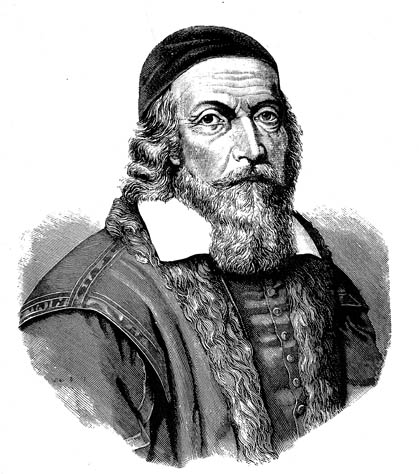
John Amos Comenius (Czech: Jan Amos Komenský; Slovak: Ján Amos Komenský; German: Johann Amos Comenius; Polish: Jan Amos Komeński; Hungarian: Comenius Ámos János; Latinized: Iohannes Amos Comenius) (28 March 1592 – 4 November 1670) was a Czech teacher, educator, and writer. He served as the last bishop of Unity of the Brethren, and became a religious refugee and one of the earliest champions of universal education, a concept eventually set forth in his book Didactica Magna. He is considered the father of modern education. He lived and worked in many different countries in Europe, including Sweden, the Polish - Lithuanian Commonwealth, Transylvania, the Holy Roman Empire, England, the Netherlands, and Royal Hungary.
Comenius originated from Moravia, but history has no accurate record of his birthplace. There are three possible locations: Komňa, Nivnice, or Uherský Brod (all three locations are in Uherské Hradiště District, southeastern Moravia, Czech Republic). His ancestors came from Hungary (likely from the part that is today Slovakia, which is very close to Moravia in location as well as in language) during the 16th century and his original family name was Szeges according to his will found in 1968 by Milada Blekastad, a monographer of Comenius.
John Comenius was the youngest child and only son of Martin Comenius and his wife Anna. Martin, whose original surname was Szeges, started to use the surname Comenius after leaving Komňa to live in Uherský Brod, where he owned a house (he was "the man who came from Komňa" = Comenius). Both of his parents belonged to the Moravian Brethren, and Comenius later became one of the leaders of that pre-reformation Protestant denomination. His parents and two of his four sisters died in 1604, and young John went to live with his aunt in Strážnice.
Due to his impoverished circumstances, he was unable to begin his formal education until late. He was 16 when he entered the Latin school in Přerov (he later returned to this school as a teacher 1614 – 1618). He continued his studies in the Herborn gymnasium (1611 – 1613) and the University of Heidelberg (1613 – 1614). Comenius was greatly influenced by the Irish Jesuit William Bathe as well as his teachers Johann Piscator, Heinrich Gutberleth, and particularly Heinrich Alsted. The Herborn school held the principle that every theory has to be functional in practical use, therefore has to be didactic (i.e., morally instructive). In the course of his study, he also became acquainted with the educational reforms of Ratichius, and with the report of these reforms issued by the universities of Jena and Giessen. Comenius' book Janua linguarum reserata (The Gate of Languages Unlocked, 1631) brought him widespread prominence and fame. However, he and the Unity became special targets of the Counter Reformation movement and were forced into exile even as his fame grew across Europe.
Comenius became rector of a school in Přerov. In 1614, he was ordained to the ministry of the Moravian Brethren, and four years later became pastor and rector at Fulnek, one of its most flourishing churches. Throughout his life, this pastoral activity was his most immediate concern. In consequence of the religious wars, he lost all his property and his writings in 1621, and six years later led the Brethren into exile when the Habsburg Counter Reformation persecuted the Protestants in Bohemia.
Comenius took refuge in Leszno in Poland, where he led the gymnasium and was given charge of the Bohemian and Moravian churches. In 1638, Comenius responded to a request by the government of Sweden and traveled there to draw up a scheme for the management of the schools of that country, and in 1641, he responded to a request by the English parliament and joined a commission there charged with the reform of the system of public education. The disturbed political condition of England interfered with the latter project, and so in 1642 he returned to Sweden to work with Queen Christina (reigned 1632 – 1654) and the chancellor Axel Oxenstierna (in office 1612 – 1654) on the task of reorganizing the Swedish schools. The same year he moved to Elbing (Elbląg) in Polish Royal Prussia, and in 1648 went to England with the aid of Samuel Hartlib, who came originally from Elbing. In 1650 Zsuzsanna Lorántffy, widow of George I Rákóczi prince of Transylvania invited him to Sárospatak. Comenius remained there until 1654 as professor in the first Hungarian Protestant college; he wrote some of his most important works there.
Comenius returned to Leszno. During the Northern Wars in 1655, he declared his support for the Protestant Swedish side, for which Polish partisans burned his house, his manuscripts, and the school's printing press in 1656. From Leszno he took refuge in Amsterdam in the Netherlands, where he died in 1670. For unclear reasons he was buried in Naarden, where visitors can see his grave in the mausoleum devoted to him.
After his religious duties, Comenius's second great interest was in furthering the Baconian attempt at the organization of all human knowledge. He became one of the leaders in the encyclopćdic or pansophic movement of the seventeenth century, and, in fact, was inclined to sacrifice his more practical educational interests and opportunities for these more imposing but somewhat visionary projects. In 1639, Comenius published his Pansophić Prodromus, and in the following year his English friend Hartlib published, without his consent, the plan of the pansophic work as outlined by Comenius. The manuscript of Pansophia was destroyed in the burning of his home in Lissa in 1657. The pansophic ideas find partial expression in the series of textbooks he produced from time to time. In these, he attempts to organize the entire field of human knowledge so as to bring it, in outline, within the grasp of every child.
According to Cotton Mather, Comenius was asked by Winthrop to be the President of Harvard University, this being more plausibly John Winthrop the Younger than his father since the junior Winthrop was in England; but Comenius moved to Sweden instead. Comenius also attempted to design a language in which false statements were inexpressible. He also wrote Protestant Hymn songbooks (Gesangbuch). A new Dutch translation of his Janua Linguarum Reserata by C.F.J. Antonides is available.
The most permanent influence exerted by Comenius was in practical educational work. Few men since his day have had a greater influence, though for the greater part of the eighteenth century and the early part of the nineteenth there was little recognition of his relationship to the current advance in educational thought and practice. The practical educational influence of Comenius was threefold. He was first a teacher and an organizer of schools, not only among his own people, but later in Sweden, and to a slight extent in Holland. In his Didactica Magna (Great Didactic), he outlined a system of schools that is the exact counterpart of the existing American system of kindergarten, elementary school, secondary school, college, and university.
In the second place, the influence of Comenius was in formulating the general theory of education. In this respect he is the forerunner of Rousseau, Pestalozzi, Froebel, etc., and is the first to formulate that idea of “education according to nature” so influential during the latter part of the eighteenth and early part of the nineteenth century. The influence of Comenius on educational thought is comparable with that of his contemporaries, Bacon and Descartes, on science and philosophy. In fact, he was largely influenced by the thought of these two; and his importance is largely due to the fact that he first applied or attempted to apply in a systematic manner the principles of thought and of investigation, newly formulated by those philosophers, to the organization of education in all its aspects. The summary of this attempt is given in the Didactica Magna, completed about 1631, though not published until several years later.
The third aspect of his educational influence was that on the subject matter and method of education, exerted through a series of textbooks of an entirely new nature. The first published of these was the Janua Linguarum Reserata (The Gate of Languages Unlocked), issued in 1631. This was followed later by a more elementary text, the Vestibulum, and a more advanced one, the Atrium, and other texts. In 1657 was published the Orbis Sensualium Pictus probably the most renowned and most widely circulated of school textbooks. It was also the first successful application of illustrations to the work of teaching, though not, as often stated, the first illustrated book for children.
These texts were all based on the same fundamental ideas: (1) learning foreign languages through the vernacular; (2) obtaining ideas through objects rather than words; (3) starting with objects most familiar to the child to introduce him to both the new language and the more remote world of objects: (4) giving the child a comprehensive knowledge of his environment, physical and social, as well as instruction in religious, moral, and classical subjects; (5) making this acquisition of a compendium of knowledge a pleasure rather than a task; and (6) making instruction universal. While the formulation of many of these ideas is open to criticism from more recent points of view, and while the naturalistic conception of education is one based on crude analogies, the importance of the Comenian influence in education has now been recognized for half a century. The educational writings of Comenius comprise more than forty titles. In 1892 the three - hundredth anniversary of Comenius was very generally celebrated by educators, and at that time the Comenian Society for the study and publication of his works was formed.
As a theologian, Comenius was mystical, a believer in prophecies, dreams and revelations. He was greatly influenced by Boehme. In his Synopsis physicae ad lumen divinum reformatae, Comenius gives a physical theory of his own, said to be taken from the book of Genesis. He was also famous for his prophecies and the support he gave to visionaries. In his Lux in tenebris he published the visions of Christopher Kotterus, Dabricius and Christina Poniatovia. Attempting to interpret the book of Revelation,
he promised the millennium in 1672, and guaranteed miraculous
assistance to those who would undertake the destruction of the Pope and
the house of Austria, even venturing to prophesy that Oliver Cromwell, Gustavus Adolphus, and George I Rákóczi, prince of Transylvania, would perform the task. He also wrote to Louis XIV of France, informing him that the empire of the world should be his reward if he would overthrow the enemies of God.
The Comenius Medal, a UNESCO award honouring outstanding achievements in the fields of education research and innovation, commemorates Comenius. Peter Drucker hailed Comenius as the inventor of textbooks and primers.
Comenius, his life and teachings, have become better known since the fall of the Iron Curtain.
During the 19th century Czech National Revival, Czechs idealised Comenius as a symbol of the Czech nation. This image persists to the present day. In 1919 Comenius University was founded by act of parliament in Bratislava, Czechoslovakia, (now in Slovakia). It was the first university with courses in the Slovak language. Slovakia and the Czech Republic celebrate 28 March, the birthday of Comenius, as Teachers' Day. University of Jan Amos Komensky has been founded in Prague. It offers bachelor's, master's and graduate degree programmes.
Gate to Languages, a project of lifelong education,
taking place in the Czech Republic from October 2005 to June 2007 and
aimed at language education of teachers, was named after his book Janua linguarum reserata (Gate to Languages Unlocked).
In Sárospatak, Hungary, a teacher's college is named after him (the college now belongs to the University of Miskolc.)
A primary school in Skopje, FYR of Macedonia is named after Comenius (Jan Amos Komenski in Macedonian). The Czechoslovak government built the school after the catastrophic earthquake in 1963 that levelled most of the city.
The Comenius Foundation is a non-governmental organisation in Poland, dedicated to the provision of equal opportunities to children under 10 years of age.
The Italian film director Roberto Rossellini took Comenius, and especially his theory of "direct vision," as his model in the development of his didactic theories, which Rossellini hoped would usher the world into a utopian future.
"Comenius", a European Union school partnership program, takes its name from the teacher of nations.
In the United Kingdom, the University of Sheffield's Western Bank Library holds the largest collection of Comenius manuscripts outside of the Czech Republic.
In 1892 Comenius Hall, the principal classroom and faculty office building on Moravian College's campus in Pennsylvania, was built. In 1892 educators in many places celebrated the three - hundredth anniversary of Comenius, and at that time the Comenian Society for the study and publication of his works was formed.
The education department at Salem College in North Carolina has an annual Comenius Symposium dedicated in his honor; the subjects usually deal with modern issues in education.
The Comenius Foundation in the US, a non-profit 501(c)(3) charity, uses film and documentary production to further faith, learning, and love.
